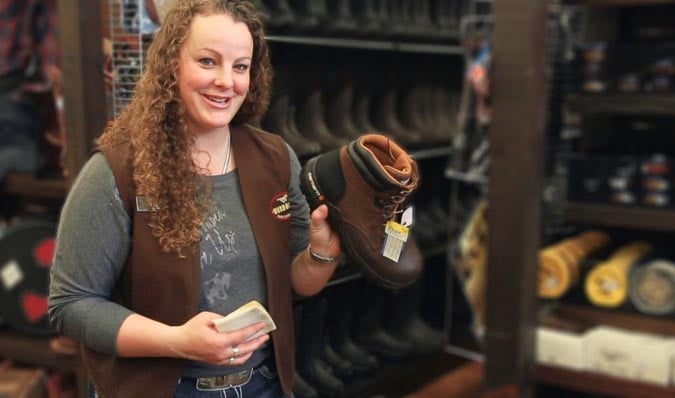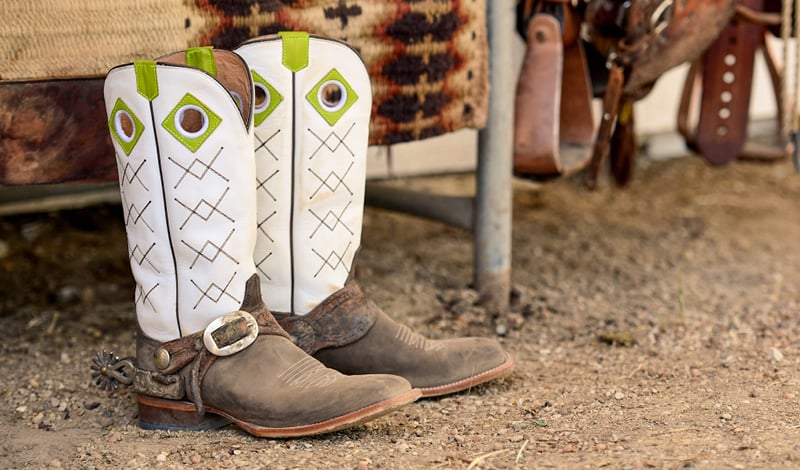
How to Keep Shoes Clean & Looking Good
Our footwear goes with us to work, outdoors, on the town, and while we’re kicking goals. But footwear gets dirty. That’s simply a fact of life, especially for our Murdoch’s customers who are no strangers to working in dirt and mud. Keeping footwear clean, looking good, and lasting longer, regardless of the material, can be done with a few household supplies and some easy steps.
Let’s get busy cleaning the most common footwear styles so they look and work their best:
Fabric Shoes
While it’s tempting to simply toss fabric shoes into a washer – many do – the washing process can warp the shoe or fray the fabric; Instead:
- Start the cleaning process by using a soft bristle brush or a dry washcloth or paper towel to loosen any surface soil.
- Use a toothbrush dipped in a soapy solution to lightly scrub soiled areas. To avoid spotting, scrub the entire shoe once the soiled areas are clean.
- Lightly moisten a paper towel with tap water and wipe the entire shoe to remove soapy residue. Repeat as necessary to cleanse the residue from the shoe.
- Use a dry towel to wipe moisture from the shoes and let them air dry.
Rubber Boots
Exterior Cleaning:
- Start with a soft brush or damp cloth to remove fresh or caked-on dirt, mud, and gunk. If the boots are laden with mud, you can start the process with a garden hose.
- Lather up your boots with a liquid hand or dish soap. Rinse them in a utility basin or with a garden hose.
- If the boots have salt stains, mix a small amount of white vinegar (carefully, not too much!) with water and rub the solution into the salt stains with a cloth. Repeat as necessary.
- Wipe the boots clean with a damp cloth. Set out to dry at room temperature.
Interior Cleaning:
- To clean the inside of Muck boots, wash the interior with a cloth moistened with equal parts water and vinegar. Reach deep, and wash the boot to the toe.
- To dry the interior of the boot, boot dryer can damage the boot. Instead, stuff the boot with newspaper and repeat three to four times. Complete the drying process by air drying the boots at room temperature.
Leather Shoes & Boots
- Remove the laces and, if they’re dirty, either replace them or wash them separately by hand or in a mesh laundry bag.
- Remove loose dirt or grime from the nooks and crevices using a soft cloth or brush. A hard-bristled brush can scratch the leather.
- Dip a soft cloth into a mixture of warm water and dish soap; wring out the water. Wipe the leather surfaces to remove debris, scuffs, and stains. With a clean, damp cloth, wipe off the soapy water. Dry with a clean towel.
- Apply a leather conditioner like Lexol or Farnam (these and others are available at Murdoch’s) to condition the leather, protecting it from stains and adding shine. After applying the conditioner to the leather with a cloth, let it sit for 10 minutes or so and buff it with a soft cloth.
- Air dry the shoes or boots in the open air, out of the sun.
Athletic Shoes
- Start by removing the laces, which can be laundered separately by hand or in a mesh laundry bag.
- Scrub off dirt with a bristled brush, scrubbing gently to avoid fraying or damaging fabric or leather.
- Use a moist cloth to rub off dirt and grime from the soles or upper. For the dirtiest canvas or pleather shoes — no leather or suede! — this step can include washing the shoes alone in a washing machine in cold water and without other clothing. A large towel or two can be included in the wash to avoid noise.
- Air dry inside and out. If the shoes have replaceable insoles, remove them and dry them separately.
Suede and Nubuck
Suede and nubuck are leather materials but are cleaned differently than leather. Leather is made from the grain side, or exterior, of leather and is smooth and durable. Suede and nubuck are made from the flesh side, or interior, of leather and are textured, often referred to as matty or napped.
- Start cleaning suede and nubuck by lightly brushing it with a dry nubuck/suede sponge or a brass or nylon suede brush from Montana Leather. For tough, more stubborn marks, push the sponge or brush deeper using its edge.
- A foaming cleaner can be a more powerful option in removing stains and soil but test it in a small area first to check for color change. Apply in a circular motion and let it dry. Once dry, brush the nap with a sponge or brush. For stubborn stains, try a nubuck eraser.
Sheepskin Boots
- Start by dampening the entire boot without soaking it.
- Clean the suede upper by putting a small amount of suede cleaner and water on a soft, damp cloth. Work the mixture into a lather and apply it to the entire outer surface of the boot. Rinse the lather from the boot.
- Use a special sheepskin shampoo to gently clean the sheepskin lining and trim. Avoid putting the shampoo directly onto the sheepskin or suede portion of the boots. Rinse thoroughly.
- Hang the boots upside down in a well-ventilated area. No sun. To help the boots keep their shape, stuff them with a rolled-up towel. Allow drying before protecting them with a stain- and water-repellent spray.
Outdoor Sandals
- Start by using a soft bristle brush to remove dirt and grime or rinse with a garden hose or under warm water in a utility basin or bucket. Slap the sandals together to clear them of stuck dirt and mud.
- Use an antimicrobial soap and warm water. Hand washes the sandal surfaces. Use a brush or cloth to apply soap to the dirtiest spots.
- A toothbrush can access tiny crevasses and small areas.
- Rinse in warm water or use a pressurized hose to clear the crevasses.
- Air dry in the open air before wearing.
Leather Sandals
- Rub off dirt with a soft brush or cloth.
- For untreated leather sandals, use a damp cloth to apply a leather conditioner or saddle soap to the dirty spots.
- Rub off the conditioner or soap with a slightly damp cloth.
- For treated leather sandals, wipe with a clean cloth moistened with equal parts water and vinegar.
- Air dry in the open air away from direct sunlight, which can damage leather.
Related Articles

Footwear
New Rules on Leather Boot Care
Waterproofing technologies are changing the rules on what you can and can’t use to condition your leather...
Read More

Footwear
How to Apply Leather Conditioner
Blair, Murdoch's Boot Specialist in Bozeman, takes us step by step on how to condition dried leather boots...
Read More

Footwear
How to Break in Western Boots
Get that perfect just-for-you fit with your preferred method to break in your new cowboy boots...